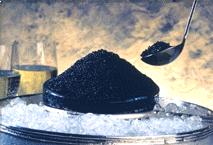|
MOSCOW, Russia, February 16, 2001 (ENS) - Scientists and caviar traders from 11 countries have gathered for the first time to address the rapid decline of the world¹s sturgeon species, highly valued for both caviar and meat. More than 40 experts, including scientists, government and non-governmental organization (NGO) representatives met caviar traders last weekend to agree on the best way to conserve and revive sturgeon populations. The meeting follows last December's report "Roe to Ruin: The Decline of Caspian Sea Sturgeon and the Road to Recovery." The report was released by campaign group "Caviar Emptor," made up of the Wildlife Conservation Society, Natural Resources Defense Council (NRDC), and SeaWeb. It explains the threats facing Caspian Sea sturgeon, particularly beluga, and the steps needed to achieve recovery. Russian and stellate sturgeon from the Caspian Sea produce the vast majority of the world's caviar. Clad in bony plates and equipped with broad snouts, sturgeon are a link to an age when dinosaurs roamed the Earth. They can grow up to 2,500 pounds and 15 feet long and live to be more than 100 years old. Sturgeon are the source of caviar - the eggs, or roe, collected from female sturgeon after she has been caught and killed. A single sturgeon can produce hundreds of pounds of roe. Today, relentless overfishing, pollution and habitat destruction mean all 27 species of sturgeon and their close relatives, paddlefish, are in sharp decline. Those living in the Caspian Sea, the cradle of world caviar production, are in crisis. Several sturgoen species are also valued for meat and, in North America, sport fishing. Additional threats include poaching, illegal trade, poor aquaculture and re-stocking techniques, lack of regional cooperation in conservation programs, and poor law enforcement. Sturgeon are migratory fish that cross international borders as part of their life cycle, so international cooperation is critical to conserve them. Delegates from Russia, China, Romania and Azerbaijan made presentations to last weekend's meeting. All indicated rapidly declining legal catches of sturgeon over several decades but particularly since the breakup of the USSR at the beginning of the 1990s. This is despite attempts by some governments of countries bordering the Caspian Sea to release millions of young fish annually. At 386,400 square kilometers, (149,200 square miles) the Caspian is the world's largest inland sea, lying east of the Caucasus Mountains and linking Europe's southeasternmost extremity with the vast, flat expanses of western Central Asia. It is bordered by Iran, Azerbaijan, Russia, Kazakstan, and Turkmenistan. The meeting reviewed the status of wild sturgeon populations, discussed conservation initiatives under way, and heard the perspectives of international traders. The sturgeon's plight appears to be most critical in the Caspian Sea, Azov Sea, Amur River and Yangtze River. "The priority problems to address include poaching and illegal trade, low efficiency of aquaculture and restocking, and a lack of international and regional cooperation for sturgeon conservation," said Dr. Mohammed Pourkazemi, chairman of the Sturgeon Specialist Group. "Attention should be directed at threats posed by dams, mining, pollution, and the lack of reliable stock assessments, adequate legislation and enforcement effort," said Pourkazemi. "There is an urgent need to restore sturgeon habitat as well as the various species that are threatened, whether or not they have a commercial value. Experts made the following recommendations to conserve sturgeon populations: Control poaching and illegal trade in caviar by drawing up regional trade and law enforcement agreements, improving the social and economic conditions of people living in areas where sturgeon are found and better enforcement of existing laws. Improve efficiency in aquaculture, population assessment and re-stocking. Experts said this could be done by developing a unified method for population assessment and forming a code of conduct for each species to increase the effectiveness of re-stocking programs. Improve regional and international cooperation for sturgeon conservation. This could be done by developing regional agreements for sturgeon conservation and management, particularly for the Amur River, the Black Sea, Azov Sea, and the Caspian Sea. This would include identifying potential protected areas in sturgeon habitat. Funding support for sturgeon conservation from major financial and economic mechanisms, such as the Global Environment Facility (GEF) and World Bank as well as the private sector. The GEF was created in 1991 to help fund action that tackles biodiversity loss, climate change, international waters, and ozone depletion. Increased public awareness of the threats facing sturgeon and opportunities for their conservation. Experts suggested an information exchange network involving all parties involved in sturgeon conservation, including the United Nations Food and Agriculture Organization, the Convention on Biological Diversity, Sturgeon Specialist Group, Convention on the Conservation of Migratory Species, and IUCN¹s European Sustainable Use Specialist Group. All sturgeon species, including the pallid sturgeon of North America, are now on the CITES list. CITES, which controls international trade in caviar and other sturgeon products and to which most producer and consumer countries are signatories, placed sturgeons on Appendix II. This means all international trade is strictly controlled by both importing and exporting countries. Given sturgeon species' continuing decline, CITES has recommended that international trade be sharply reduced until producer countries can show that any proposed trade will not threaten the species in the wild. Lower catch quotas would be in keeping with a trend noted by many caviar traders at the Moscow meeting. In addition to their concerns over declining sturgeon numbers and escalating prices, traders reported a marked fall in consumer demand. "
|

